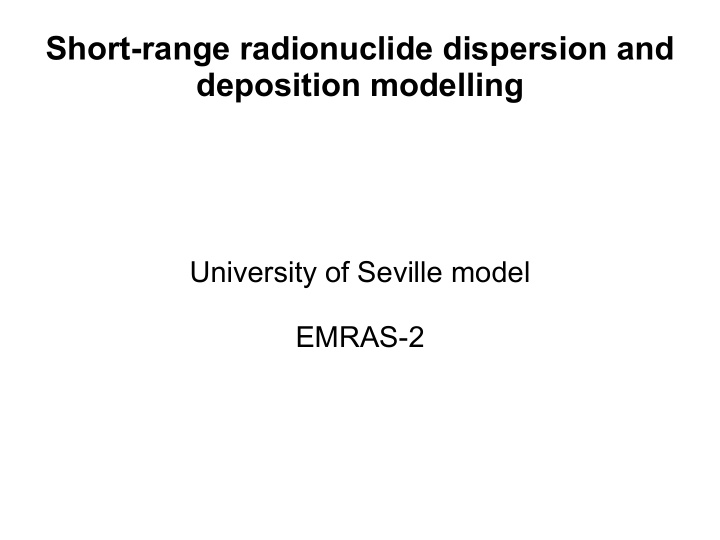



Short-range radionuclide dispersion and deposition modelling University of Seville model EMRAS-2
Model characteristics ● Model specifically designed and developed for the exercise ● Lagrangian dispersion model: 10000 particles released – 5000 liquid particles – 5000 gas particles ● Each particle contains an amount of Bq depending on activity in explosive and on fractionation between liquid and gas ● The model does not try to reproduce the explosion itself, but dispersion just after it ● Differences between liquid and gas particles: – Initial conditions – Dispersion processes
Geometry of model domain ● Explosion site: origin of coordinates ● z axis directed upwards ● Results are provided on the rectangular box
Liquid particles ● Dispersion processes: ● Parabolic motion with air friction given an initial position and velocity of each particle ● Advection with wind ● Initial position: anywhere within the explosive shielding (Monte Carlo method) ● Initial velocity: ● A mean value v0 (m/s) and error (%) are introduced as input data ● It is assumed that v0 magnitude obeys a normal distribution with the given mean value and standard deviation ● The actual value for a given particle is obtained from a Monte Carlo method ● The direction of v0 is limited by the explosive shielding (opened on one side and top):
Liquid particles The actual direction is again obtained from a Monte Carlo method (all possible angles have the same probability)
Gas particles ● Initial positions: particles form a cloud over the explosion site at an effective height ± 2 m. The actual position for a given particle is obtained from a Monte Carlo method (all positions have the same probability) ● Dispersion: ● Advection by wind ● Turbulent diffusion (Monte Carlo method) ● Radioactive decay (liquid and gas particles): Monte Carlo method
Summary of model parameters ● Calibrated: – Initial velocity and error for liquid particles – Friction coefficient with air – Effective release height for gas particles – Fraction of activity released as aerosol (some indications are given in the scenario description) ● Standard values: – Turbulent diffusion coefficient in air – Radioactive decay constant – Dose conversion factor
Summary of model parameters ● From scenario: – Horizontal angle α – Vertical angles β1 and β2 – Wind velocity components – Explosive shielding dimensions – Activity in explosive – Time from activity determination to explosion ● Simulation inputs: – Time step for model integration – Simulation time
Example of input file input data for explosion code: test2 ----------------------------- 12.,40. initial particle velocity (m/s), tolerance (%) 40. initial horizontal dispersion angle 30.,90. vertical angles 0.93,0. wind velocity components (m/s) 0.001 friction coefficient of liquid particles with air 30. diffusion coefficient in air (m^2/s) 100 simulated time (sec) .01 time step (s) .80,.50 box explosive dimensions x,y (m) 1058.e6 total activity (Bq) 3.20e-5 radioactive decay constant (s-1) 80. time in minutes from activity determination to explosion
Model output ● Deposited activity on the ground on a 1×1 m grid ● Dose rates on the same grid (USEPA report EPA-402- R-93-081) ● Time integrated concentrations in air on the same grid and as function of height (1 m resolution) up to 30 m ● Requested results: – 50, 75 and 95 percentiles of total deposited activity (radius of a circle containing such fraction) – Surface contamination and dose rates on a 5×5 m grid – Time integrated air concentrations along centerline over 5 m intervals and as a function of height
100% of activity in liquid particles Log10 scales
100% of activity in aerosol fraction Effective release height: 15 m Log10 scales
Test 2 results Log10 scales
Test 2 results Log10 scales
Test 2 results
Test 2 results
Test 2 results Time integrated air concentrations along centerline over 5 m intervals
Recommend
More recommend